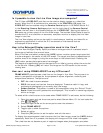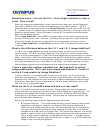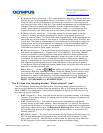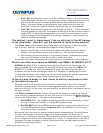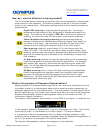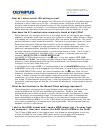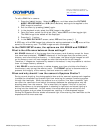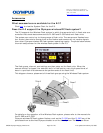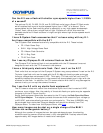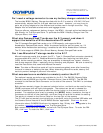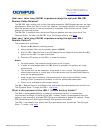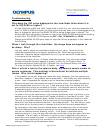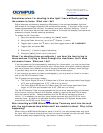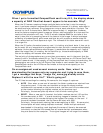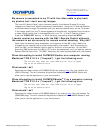
DIGITAL TECHNICAL SUPPORT
OLYMPUS IMAGING AMERICA INC.
(888) 553-4448
http://support.olympusamerica.com
©2008 Olympus Imaging America Inc. Page 24 of 26 Last updated on February 28, 2008
When I put a formatted CompactFlash card in my E-3, the display shows
a capacity of RAW files that doesn’t appear to be accurate. Why?
When the E-3 saves a captured image as digital data and writes it onto the memory
card, it performs complex mathematical calculations to convert it to binary code data to
be saved and later retrieved. Since images are unique, each calculation is unique. The
manual for the E-3 shows that a RAW file is approximately 11 megabytes. However,
since the factors comprising each image are unique, each calculation is unique and the
results of the calculation will vary. The E-3 writes a lossless RAW file, and one of the
ways it does this is by sampling some of the factors in the image. A winter landscape
consisting of predominantly white snow and blue sky will produce a smaller data file
than a scene such as Times Square at night. The richness of the latter scene will result
in a larger file.
When the E-3 polls a formatted memory card, it is looking at a blank slate. It has yet to
do the math for any images and is programmed to start out with a conservative capacity
estimate. As the camera shoots more images, it recalculates the capacity as it “learns”
about the image files it is creating. As the card fills up, the estimated capacity of RAW
files on the display will become more accurate.
The majority of photographers carry more than one memory card in the event that the
memory card in the camera should fill up. The E-3 also features an xD-Picture Card™ slot
to hold a second card. If the capacity of the CompactFlash card is close to maximizing, the
photographer can switch to the xD-Picture Card media or can transfer files from the
CompactFlash card to the xD-Picture Card media to free up more capacity on the
CompactFlash card.
On an assignment used several memory cards. Now, when I’m
downloading the images onto my computer and trying to save them,
I get a message that says, “Image file_name.jpg already exists.
Replace it with the new file?” What’s going on?
The E-3 has two settings for creating file names for the images it captures:
• AUTO - Even when a new card is inserted, the folder numbers are retained from
the previous card. If the new card contains an image file whose number
coincides with one saved on the previous card, the new card’s file numbers start
at the number following the highest number on the previous card.
Put simply, the camera picks up where it left off when naming files.
• RESET - When a new card is inserted, the folder numbers start at 100 and the
file numbers start at 0001. If a card containing images is inserted, the file
numbers start at the number following the highest file number on the card. If
the card has been formatted, the file names will start with 0001.
Put simply, the card starts naming files anew beginning at 0001. At some point,
the computer will start seeing duplicate numbers. When multiple cards are
downloaded in this setting, each duplicate file name will have to be renamed
individually or else the like-named files will overwrite their predecessors when
they are saved to the computer. The original images will no longer be viewable.



